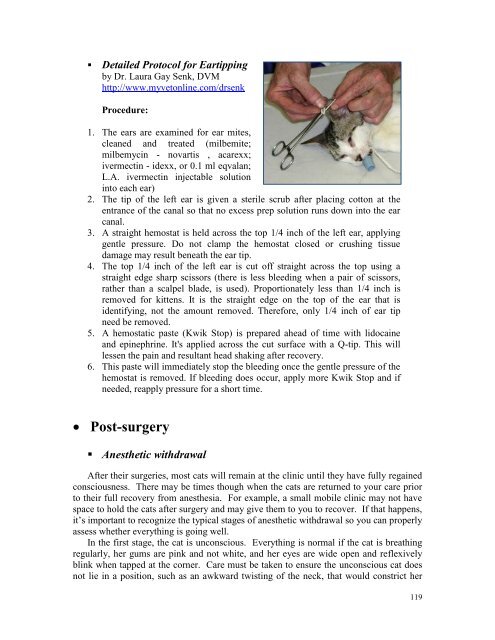download/print - Neighborhood Cats
download/print - Neighborhood Cats
download/print - Neighborhood Cats
- No tags were found...
Create successful ePaper yourself
Turn your PDF publications into a flip-book with our unique Google optimized e-Paper software.
• Detailed Protocol for Eartippingby Dr. Laura Gay Senk, DVMhttp://www.myvetonline.com/drsenkProcedure:1. The ears are examined for ear mites,cleaned and treated (milbemite;milbemycin - novartis , acarexx;ivermectin - idexx, or 0.1 ml eqvalan;L.A. ivermectin injectable solutioninto each ear)2. The tip of the left ear is given a sterile scrub after placing cotton at theentrance of the canal so that no excess prep solution runs down into the earcanal.3. A straight hemostat is held across the top 1/4 inch of the left ear, applyinggentle pressure. Do not clamp the hemostat closed or crushing tissuedamage may result beneath the ear tip.4. The top 1/4 inch of the left ear is cut off straight across the top using astraight edge sharp scissors (there is less bleeding when a pair of scissors,rather than a scalpel blade, is used). Proportionately less than 1/4 inch isremoved for kittens. It is the straight edge on the top of the ear that isidentifying, not the amount removed. Therefore, only 1/4 inch of ear tipneed be removed.5. A hemostatic paste (Kwik Stop) is prepared ahead of time with lidocaineand epinephrine. It's applied across the cut surface with a Q-tip. This willlessen the pain and resultant head shaking after recovery.6. This paste will immediately stop the bleeding once the gentle pressure of thehemostat is removed. If bleeding does occur, apply more Kwik Stop and ifneeded, reapply pressure for a short time. Post-surgery• Anesthetic withdrawalAfter their surgeries, most cats will remain at the clinic until they have fully regainedconsciousness. There may be times though when the cats are returned to your care priorto their full recovery from anesthesia. For example, a small mobile clinic may not havespace to hold the cats after surgery and may give them to you to recover. If that happens,it’s important to recognize the typical stages of anesthetic withdrawal so you can properlyassess whether everything is going well.In the first stage, the cat is unconscious. Everything is normal if the cat is breathingregularly, her gums are pink and not white, and her eyes are wide open and reflexivelyblink when tapped at the corner. Care must be taken to ensure the unconscious cat doesnot lie in a position, such as an awkward twisting of the neck, that would constrict her119








